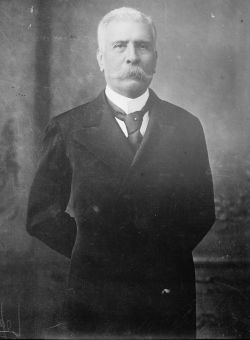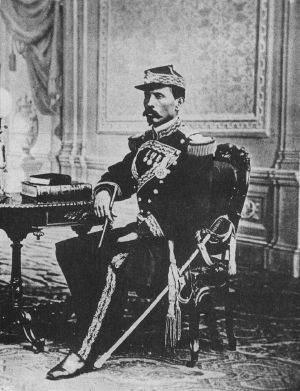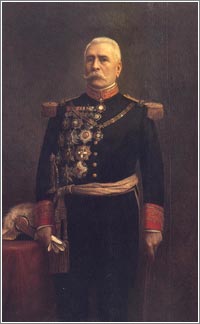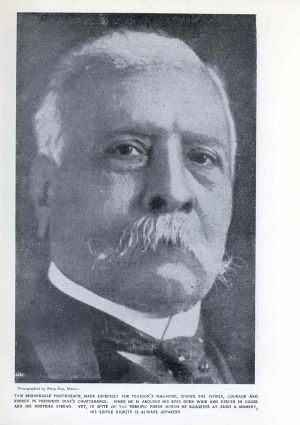Difference between revisions of "Porfirio Díaz" - New World Encyclopedia
Lindsay Hull (talk | contribs) (New page: {{Infobox_President | name=José de la Cruz Porfirio Díaz Mori | nationality=Mexican | image=Porfirio_Diaz_civilian.jpg | order= President of Mexico | term_start=November 29, [[1...) |
Lindsay Hull (talk | contribs) |
||
| Line 1: | Line 1: | ||
| − | {{ | + | {{Infobox Person | name=José de la Cruz Porfirio Díaz Mori [[President of Mexico]] |
| nationality=Mexican | | nationality=Mexican | ||
| image=Porfirio_Diaz_civilian.jpg | | image=Porfirio_Diaz_civilian.jpg | ||
| − | |||
| term_start=[[November 29]], [[1876]] - [[December 6]], [[1876]], [[February 17]], [[1877]] | | term_start=[[November 29]], [[1876]] - [[December 6]], [[1876]], [[February 17]], [[1877]] | ||
| term_end=[[November 30]], [[1880]]<br>[[December 1]], [[1884]] – [[May 25]], [[1911]] | | term_end=[[November 30]], [[1880]]<br>[[December 1]], [[1884]] – [[May 25]], [[1911]] | ||
| Line 147: | Line 146: | ||
[[Category:1830 births]] | [[Category:1830 births]] | ||
[[Category:1915 deaths]] | [[Category:1915 deaths]] | ||
| − | |||
| − | |||
| − | |||
| − | |||
| − | |||
| − | |||
| − | |||
| − | |||
| − | |||
| − | |||
| − | |||
| − | |||
| − | |||
| − | |||
| − | |||
| − | |||
| − | |||
| − | |||
| − | |||
| − | |||
| − | |||
| − | |||
| − | |||
| − | |||
| − | |||
| − | |||
| − | |||
{{Credits|163417243}} | {{Credits|163417243}} | ||
Revision as of 03:49, 10 October 2007
| José de la Cruz Porfirio Díaz Mori President of Mexico | |
 | |
| Born | September 15 1830 Oaxaca, Oaxaca |
|---|---|
| Died | July 2 1915 (aged 84) Paris, France |
| Nationality | Mexican |
| Predecessor | Sebastián Lerdo de Tejada (1876) Juan N. Méndez (1877) Manuel González (1884) |
| Successor | Juan N. Méndez (1876) Manuel González (1880) Francisco León de la Barra (1911) |
| Political party | Liberal |
| Spouse(s) | * Delfina Ortega * Carmen Romero Rubio |
José de la Cruz Porfirio Díaz Mori (15 September 1830 – 2 July 1915) was a Mexican-American War volunteer, French Intervention hero, and President. He ruled Mexico from 1876 to 1880 and from 1884 to 1911.
Early years
Porfirio Díaz was born in 1830 in the city of Oaxaca, Oaxaca. He was a mestizo, of Creole and Mixtec (a Mesoamerican tribe) ancestry. His father, José Faustino (de la Cruz) Díaz Bohorques was a modest innkeeper and died when Porfirio Díaz was three years old. His mother, Petrona Mori Cortés, later tried to keep the inn going but the business failed. She sent young Porfirio to the Seminario Conciliar in 1843, but he was not cut out for the priesthood. He joined the local militiary in 1846, dreaming of defending his country from a threatening United States invasion. In 1850 Porfirio entered the Instituto de Ciencias y Artes to study law.
Military career
Díaz soon became a prominent local activist and politician in the liberal opposition to the conservative Santa Anna dictatorship.
In 1858 during the War of the Reform he participated in the occupation of Oaxaca. In April of that year the state governor appointed Díaz military commander and governor of the Department of Tehuantepec. That same year he was promoted to major. In 1859 he was promoted to lieutenant colonel.
In 1860 following his victory in Ixtepeji, north of Oaxaca, he was promoted to colonel. In 1861 in recognition of his victory in Jalatlaco he was promoted to brigadier general.
Battle of Puebla (5th of May)
The participation of General Porfirio Díaz in the Battle of Puebla that took place May 5 1862 is commonly mistaken with that of the general's brother, Felix Díaz. It is believed that General Díaz led the volunteer cavalry that protected the flanks of the Mexican army during the battle, but this was in fact his brother Felix who was in charge of a unit of volunteer lancers. By the time of the battle, General Díaz had reached the rank of brigade general in charge of an infantry brigade.
According to the biography written by General Bernardo Reyes, General Díaz's brigade was placed in the center between the forts of Loreto and Guadalupe, where he repelled a French infantry attack that was sent as a diversion to distract the Mexican commanders' attention from the forts that were the main target of the French army. General Díaz with his unit fought off a larger French force and then chased after them, in violation of the orders of General Ignacio Zaragoza, who commended the actions of General Díaz during the battle as "brave and notable". There was a second battle of Puebla, fought April 2, in which the Díaz did lead cavalry units against conservative positions around the city.
In 1863 Díaz was captured by the French Army. He escaped and was offered by President Benito Juárez the positions of secretary of defense or army commander in chief. He declined both but took an appointment as commander of the Central Army. That same year he was promoted to Division General (similar to Lieutenant General).
In 1864 the conservatives supporting Emperor Maximilian asked him to join the imperial cause. Díaz refused. In 1865 he was captured by the Imperial forces in Oaxaca. He escaped and fought the battles of Tehuitzingo, Piaxtla, Tulcingo and Comitlipa. In 1866 Díaz formally declared his loyalty to Juárez. That same year he earned victories in Nochixtlan, Miahuatlan and la Carbonera and once again captured Oaxaca. He was then promoted to general. Also in 1866, Marshal Bazaine, commander of the Imperial forces, offered to surrender Mexico City to him if Díaz withdrew support of Juárez. The offer was declined.
In 1867, Emperor Maximilian offered Díaz the command of the army and the imperial rendition to the liberal cause. Díaz refused both. He went on to win the final battle for Puebla on April 2, 1867.
He remained popular well after the defeat of the French and the death of Juárez in 1872.
Rise to power and political career
In 1870, Díaz ran as presidential candidate against President Juárez and Vice President Sebastián Lerdo de Tejada. In 1871 he made claims of fraud in the July elections won by Juárez, who was confirmed as president by the Congress in October. In response, Díaz launched the Plan de la Noria (November 8, 1871), supported by a number of rebellions across the country. In March of 1872 Díaz's forces were defeated in the battle of La Bufa in Zacatecas. Following Juárez's death on July 9 of that year Sebastián Lerdo de Tejada assumed the presidency and then offered amnesty to the rebels. Díaz accepted in October and "retired" to the Hacienda de la Candelaria in Tlacotalpan, Veracruz.
In 1874 he was elected to the Mexican Congress from Veracruz. That year Lerdo de Tejada's government faced civil and military unrest, and offered Díaz the position of ambassador to Germany, which he refused. In 1875 Díaz traveled to New Orleans and Brownsville, Texas to plan a rebellion, which was launched in Ojitlan, Oaxaca on January 10, 1876, as the Plan de Tuxtepec.
After appointing himself president on November 29, 1876, he served one term and then stepped down in favor of his hand-picked successor Manuel González, one of his underlings. The four-year period that followed was marked by corruption and official incompetence, so that when Díaz stepped up in the next election he was a welcome replacement, and there was no remembrance of his "No Re-election" slogan. During this period the Mexican underground political newspapers spread the new ironic slogan for the Porfirian times, based on the slogan "Sufragio Efectivo, No Reelección" (Effective suffrage, no re-election) and changed it to "Sufragio Efectivo No, Reelección" (No effective suffrage, Re-election). In any case Díaz had the constitution amended, first to allow two terms in office, and then to remove all restrictions on re-election.
He maintained power through manipulation of votes, but also through simple violence and assassination of his opponents, who consequently were few in number. He was a cunning politician and knew very well how to manipulate people to his advantage. A phrase used to describe the order of his rule was "Pan, o palo" ("Bread, or the stick"), meaning that one could either accept what was given willingly, or face harsh consequences. From 1892 onwards Díaz's perennial opponent was the eccentric Nicolás Zúñiga y Miranda, who lost every election but always claimed fraud and considered himself to be the legitimately elected president of Mexico.
Economic development, human exploitation
Díaz embarked on a program of modernization, attempting to bring Mexico up to the level of a modern state. His principal advisers were of a type called científicos, akin to modern "technocrat" economists, because they espoused a program of "scientific" modernization, including the building of railroad and telegraph lines across the country, including the first Mexican railway (between Veracruz and Mexico City). Under his rule the amount of track in Mexico increased tenfold; many of these rails remain in operation today without remodelling. He introduced the idea of steam machines and technological appliances in industry and invited and welcomed foreign investment in Mexico. He also encouraged the construction of factories in Mexico City. This resulted in the rise of an urban proletariat and the influx of foreign capital (principally from the United States).
Early in his career, Díaz realized that the principal foreign threat to Mexico was the United States, and that the Mexican army stood no chance of defeating the U.S.A. Díaz adjusted Mexican foreign policy to keep the peace with the U.S.A., reduced the size of the Mexican army and used the peace dividend to put Mexico's budget into better condition.
The growing influence of U.S. businessmen, already a sore point in a Mexico that had lost much land to the United States, was a constant problem for Díaz. His modernization program was also at odds with the owners of the large plantations (haciendas) that had spread across much of Mexico. These rich plantation owners wanted to maintain their existing feudal system (peonage), and were reluctant to transform into the capitalist economy Díaz was pushing towards because it meant competing in a global market and contending with the monetary influence of businessmen from the United States.
Though he wished to modernize the country, Díaz by no means opposed the existence of the haciendas, and in fact supported them strongly throughout his rule. He appointed sympathetic governors and allowed the plantation owners to proceed with a slow campaign of encroachment, using the Ley Lerdo, onto collectively owned village land, and enforced such seizure through his well-equipped rural police (rurales).
Collapse of the regime
In a 1908 interview with the U.S. journalist James Creelman, Díaz stated that Mexico was ready for democracy and elections and that he would step down and allow other candidates to compete for the presidency. The governor of Nuevo León, Bernardo Reyes, announced his plans to run for president. However, Díaz sent Reyes on a mission to Europe, so Reyes was unable to compete in the elections.
University of California, Berkeley–educated Francisco I. Madero answered the call for candidates. Although Madero was very similar to Díaz in his ideology, he hoped for other elites in Mexico to rule alongside the president, unlike Díaz. Díaz, however, did not approve of Madero and had him jailed during the election in 1910.
Despite this, the election went ahead. Madero had gathered much popular support, but when the official results were announced by the government, Díaz was proclaimed to have been re-elected almost unanimously, with Madero gathering only a minuscule number of votes. This undisputable case of massive electoral fraud aroused widespread anger. Madero called for revolt against Díaz, and the Mexican Revolution began. Díaz was forced from office and fled the country for France in 1911. Madero was assassinated in 1913.
In 1915, Díaz died in exile in Paris; he is buried there in the Cimetière du Montparnasse.
Quotations
- Díaz is usually credited with the saying, "¡Pobre México! ¡Tan lejos de Dios y tan cerca de los Estados Unidos!" (Poor Mexico, so far from God and so close to the United States!)
- Referring to his policy of coopting political opponents, Díaz reportedly said, "a dog with a bone neither barks nor bites" or "a dog with a bone in its mouth neither steals nor kills."
- As he headed for exile in May 1911 following the revolt by Francisco Madero, Díaz reportedly remarked, "Madero has unleashed a tiger; let’s see if he can control it."
See also
- History of Mexico
- 1884 in Mexico
- Painting of Porfirio Díaz, Phoenix Art Museum
ReferencesISBN links support NWE through referral fees
Garner's revisionist biography is the current standard in the field.[citation needed]
- Porfirio Díaz, by Paul Garner (2001).
- Revolutionary Mexico: The Coming and Process of the Mexican Revolution, by John Mason Hart (1989).
- The Mexican Revolution, by Alan Knight (1986).
- Juárez and Díaz: Machine Politics in Mexico, by Laurens Ballard Perry (1978).
- The Age of Porfirio Díaz: Selected Readings, by Carlos Gil (1977).
- Mexican Revolution: Genesis Under Madero, by Charles C. Cumberland (1974).
- The United States Versus Porfirio Díaz, by Daniel Cosío Villegas, trans. by Nettie Lee Benson (1963).
- Porfirio Díaz, Dictator of Mexico, by Carleton Beals (1932).
- Díaz, by David Hanney (1917).
- Porfirio Díaz, president of Mexico, the master builder of a great commonwealth, by Jose Francisco Godoy (1910).
- Life of Porfirio Díaz, by Hubert Howe Bancroft (1885).
- Mexico Barbaro, by John Kenneth Turner.
External links
- Historial Text Archive: Díaz, Porfirio (1830-1915)
- Works by Porfirio Díaz. Project Gutenberg
- The New Student's Reference Work/Diaz, Porfirio
- Creelman's interview in Spanish
- Creelman's interview in English
| Preceded by: Sebastián Lerdo de Tejada |
President of Mexico 1876 |
Succeeded by: Juan N. Méndez |
| Preceded by: Juan N. Méndez |
President of Mexico 1877–1880 |
Succeeded by: Manuel González |
| Preceded by: Manuel González |
President of Mexico 1884–1911 |
Succeeded by: Francisco León de la Barra |
Credits
New World Encyclopedia writers and editors rewrote and completed the Wikipedia article in accordance with New World Encyclopedia standards. This article abides by terms of the Creative Commons CC-by-sa 3.0 License (CC-by-sa), which may be used and disseminated with proper attribution. Credit is due under the terms of this license that can reference both the New World Encyclopedia contributors and the selfless volunteer contributors of the Wikimedia Foundation. To cite this article click here for a list of acceptable citing formats.The history of earlier contributions by wikipedians is accessible to researchers here:
The history of this article since it was imported to New World Encyclopedia:
Note: Some restrictions may apply to use of individual images which are separately licensed.



